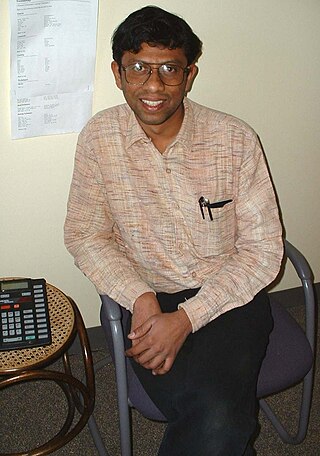Top Qs
Timeline
Chat
Perspective
Rajesh Gopakumar
Indian physicist From Wikipedia, the free encyclopedia
Remove ads
Rajesh Gopakumar (born 1967) is an Indian theoretical physicist and the director of the International Centre for Theoretical Sciences (ICTS-TIFR) in Bangalore, India. He was previously a professor at Harish-Chandra Research Institute (HRI) in Prayagraj, India.[1] He is known for his work on topological string theory.
Remove ads
Background
Gopakumar was born in 1967 to Jaishree and G. Gopakumar in Kolkata.[citation needed] His family hails from the southern Indian state of Kerala.[2] He has the distinction of securing All Indian Rank 1 in the examination for IIT-JEE in 1987.[3]
Gopakumar obtained his integrated M.Sc. degree in physics from the prestigious IIT Kanpur in 1992. He completed his Ph.D. from Princeton University in 1997 under the supervision of David Gross. After a few years as a research associate at Harvard University, he joined HRI in 2001. He was also a visiting fellow at the Institute for Advanced Study, Princeton, New Jersey from 2001 to 2004.[4]
He is married to Rukmini Dey, a Professor of Mathematical Physics and Geometry at ICTS-TIFR.[5]
Remove ads
Research
Gopakumar is a string theorist. Earlier on in his career, his research was primarily focused on large N gauge theories with David Gross, noncommutative gauge theories with Andrew Strominger and Shiraz Minwalla, and topological string theory and gauge/geometry correspondence with Cumrun Vafa and is particularly known for proposing the Gopakumar–Vafa duality and Gopakumar–Vafa invariants.[6]
Later, his work focused on attempts to derive the AdS/CFT correspondence, and on minimal model holography (with Matthias Gaberdiel). In recent years, he has made important contributions to higher spin theories and their connections with string theory (with Matthias Gaberdiel). [citation needed]He has also recently worked on the Conformal bootstrap.
Remove ads
Awards
- B.M. Birla Science Prize in Physics, 2004[7]
- ICTP Prize, 2006[8]
- Shanti Swarup Bhatnagar Award, 2009[2]
- TWAS Prize in Physics, 2013[9]
He was named Fellow of the Global Young Academy of Scientists for 2010.[1][10] He is a member of the Indian National Science Academy, and the Indian Academy of Sciences.[11]
Selected publications
- Dijkgraaf, Robbert; Gopakumar, Rajesh; Ooguri, Hiroshi; Vafa, Cumrun (2006). "Baby universes and string theory". International Journal of Modern Physics D. 15 (10): 1581–1586. Bibcode:2006IJMPD..15.1581D. doi:10.1142/s0218271806008978. S2CID 199676528. Archived from the original on 15 December 2012. Retrieved 4 June 2007.
- David, Justin R.; Gopakumar, Rajesh (17 January 2007). "From spacetime to worldsheet: Four point correlators". Journal of High Energy Physics. 0701:063 (1): 063. arXiv:hep-th/0606078. Bibcode:2007JHEP...01..063D. doi:10.1088/1126-6708/2007/01/063. S2CID 8336127. Archived from the original on 15 December 2012. Retrieved 4 June 2007.
- List of R. Gopakumar's Publications
Remove ads
References
Wikiwand - on
Seamless Wikipedia browsing. On steroids.
Remove ads

